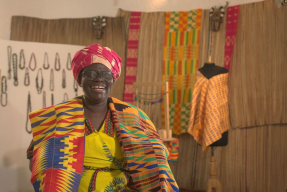Looking at Microfinance Through Rose-Coloured Glasses
January 29, 2010By Taylor Akin, KF9, Togo
There is a lot of hype surrounding microfinance. For some, microfinance is an effective tool used to promote large-scale poverty alleviation. For others, it is simply considered a way for moderately poor individuals to better their own situations. If you’re reading this blog, you likely fit somewhere on this spectrum of belief that microfinance does at least some good. While the degree to which microfinance impacts the lives of the poor is often debated, the hype remains fairly constant. But can microfinance really live up to the publicity that precedes it?
I must admit that I too was a victim of this hype. I naively thought that my work as a Kiva Fellow would include listening to many heart-wrenching, life-changing stories of success and failure as a result of, or despite the efforts of microfinance. My friends at home often joked that I was off to “save the world.”
Granted, we were well warned during our training at Kiva Headquarters that this would not be the case. On the first day of training, we were instructed to write down the following words, “Four weeks in, microfinance sucks.” We were told that, four weeks into our placement, we would likely find ourselves disappointed with the overall institution of microfinance. The hope is that, by the end of our placement, we will have formed a well-rounded opinion of microfinance – good or bad. We were also warned that the frequency of hearing earth shattering stories would be limited. If we were lucky, we might hear one over the course of our entire placement.
Despite the warnings, I put on my rose-coloured glasses and set out for the field. Now, as the 7th week of my placement with WAGES comes to an end, I have over 50 interviews with entrepreneurs under my belt. With each interview, I felt a little more crestfallen when I was met with the standard responses to my questions: “I used the loan to buy stock,” “I used the profits to reinvest in my business,” “The main challenge I face is a lack of demand,” “This loan has had a positive impact,” and finally “I want to expand my business.” This interview was often followed by me desperately trying to catch a photo with the entrepreneur smiling, despite their persistent solemn glare into the camera lens.
Yet, all this disappointment made me realize something. Maybe the hype surrounding microfinance is justified after all. Perhaps, we just need to dig a little deeper.
How has this loan affected your life?
Overwhelmingly, the entrepreneurs I have interviewed reported that their loan had a positive impact on both their personal and professional lives. That is certainly something to be proud of. Even if most entrepreneurs choose not to elaborate on the details, we can certainly appreciate the immensity of this simple statement. In fact, only one interviewed borrower out of 50 reported that her life was worse off since taking out her loan (click here to find out why). In this case, the percentage says it all.
What are the challenges you’ve faced in your work?
As Kiva Fellows, we look to this portion of the interview to give our journals some meat. Yet, many WAGES entrepreneurs have few obstacles to report in their work. Quite often, an occasional lack of demand is the main challenge they face. In reality, it is a relief that they don’t encounter more impossible obstacles in their work. Specifically, a lack of demand can only be a problem when faced with an abundant supply. While some WAGES clients may deal with periods of low demand, their microloan has enabled them to adequately supply their customers when demand is high.
What are your plans for the future?
The majority of entrepreneurs hope to expand their business in the future. While this common response can be predictable, it is also really quite moving. Often singlehandedly, these individuals have created businesses, however big or small. On a daily basis they interact with customers, replenish their stock, and use the profits to support themselves. In some cases, it may have taken several loan cycles for these entrepreneurs to get to where they are now. Yet, this shared vision of expanding their business is the driving force that fuels them. They all dream of serving and satisfying more customers. These ambitions should not be erased simply by virtue of hearing the words “I want to expand my business” several times a day.
No, these stories do not recount experiences of emerging from destitute poverty to become a successful entrepreneur. In many cases, these entrepreneurs were already prospering, and this prosperity did not occur over night. The differences between pre- and post- loan may not be earth shattering, but microfinance helped them to become even more successful over an extended period of time.
Is it possible my conceptualization of microfinance hype was informed by the poverty porn we are so often subjected to? Guilty as charged. I was looking for stories of transformation, emergence from the ashes, and overcoming impossible odds. Perhaps, I was just looking in all the wrong places. Why is it that tragedy and sadness are prerequisites to measuring success? The importance is in recognizing the positives objectively and not trying to evaluate them based on the negatives that precede them. As Kiva lenders, we want to know that our loan has had an impact. In most cases, these loans have positively affected the entrepreneurs we support, but the effects may not be as tangible as we’d like. But, if we forget what we’re looking for and instead just see what is really there, we will find that microfinance truly does have an amazing story to tell. Sometimes, we’re better off without the rose-coloured glasses.
Please join the WAGES lending team and see all fundraising WAGES loans here.















